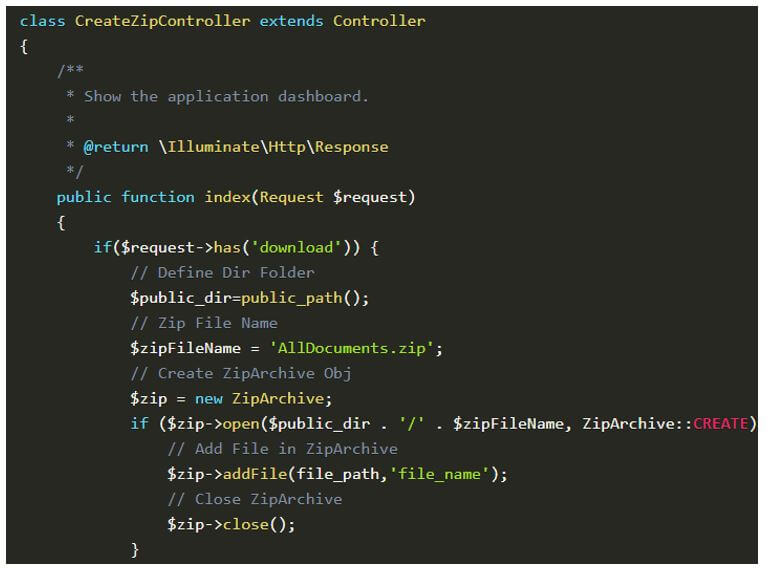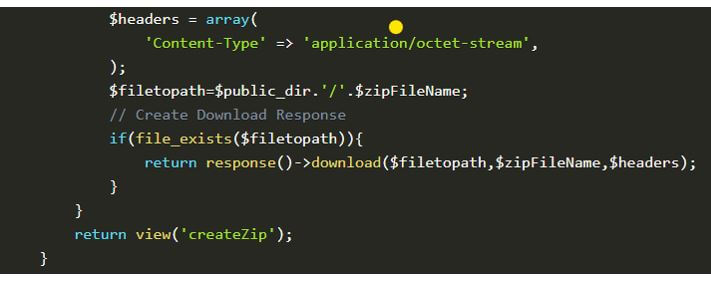Updated February 17, 2023

Introduction to Laravel Ziparchive
The ziparchive method allows users to add the file, create new directories, and view the zip folder’s content. Ziparchive is a class instead of a process, containing multiple ways. The user can do a variety of functions in the zip method. For example, the user can add a new directory, create a new file, close the archive file, extract the content of ziparchive, and perform various functions in laravel. This article explains the functionality creation of many files into a single zip file using the ziparchive class in laravel.
What is Laravel Ziparchive?
Multiple syntaxes are available in the ziparchive class, but no various methods are included. Ziparchive is a simple class that contains numerous ziparchive techniques present in the zip to access and read the contents of the zip. But the syntax shows a better understanding of handling the ziparchive class. The user can make various operations like creating a new directory, adding new files, closing the archived files, retrieving the content of files in ziparchive, and other basic operations.
Ziparchive can be opened by using the following syntax:
Ziparchive -> open ('user_file_name');The user can give the above syntax to pass the file name that should be opened. The methods can be worked by using the instances of the ziparchive class.
Ziparchive can be closed by using the following syntax:
Ziparchive -> close();The user can call it a comparative method in the ziparchive instance to quit files in a class of ziparchive. To imply any method in the class of ziparchive, the user can implement or call any method and perform every essential operation within the ziparchive class using the Ziparchive method.
As the name implies, the ziparchive method is used to compute the zip in PHP, but at times the ziparchive is not a class or method; it holds different ways to execute operations within the ziparchive. To manage the classes in ziparchive, the user can quickly implement instances of ziparchive and call any method. This instance helps the user to implement simple operations like opening a file, creating a new directory, closing a file, opening a new file, viewing the contents of ziparchive, and other fundamental operations.
The user can execute laravel packages which provide the option to create functionalities in zipping, and it’s compact and easy to implement. This article discusses the creation of a zip file and managing the ziparchive class, which can be done without installing an extra package.
How to Create Laravel Ziparchive?
Inside the classes of PHP, ziparchive is one of the essential functions to work with all the associated functions of zip task and zip functionalities such as adding an extra file to zipping, creating a new file in the zip, adding some directories in zipping, add a new directory in zipping and so on.
The laravel ziparchive is created by the following steps:
Step 1: Route creation
The user needs to create a single route within the path of the web.php file by using the following syntax.
Route:: get ( 'create-zip', 'Create Zip Controller @index') -> name (' create-zip ');Output:
Step: 2 Controller creation
Once the route is created under a particular path, the user should create a zip controller using the option create zip controller, or he can make it by executing the command in the terminal or prompt window. Finally, the user can execute the code inside the file.
After creating the route, the user must create a CreateZipController controller using the following command in your terminal or cmd.
The following syntax should be used:
PHP make:: controller Create Zip ControllerAfter executing the command, the zip controller file inside a specific folder is created on the specified path app/ HTTP/ controllers. Next, the user should open the file and compile the necessary code inside the file.
Laravel Ziparchive Add More Files
If the user wants to add multiple files in the created zip folder, he can work on a snippet of code to execute in the class of ziparchive.
Code:
If ( $ zip -> new filename open ( $ public_dir. '/' . $ zip File Name, Zip Archive :: CREATE ) = = = TRUE)
{
// to add multiple files
For each ($ file name as $ file)
{
$ zip -> add File ($ file -> path, $ file -> name);
}
$ zip ->close name of the file();
}Creation of the new blade file:
After creating the route and controller, the blade file should be executed using the simple layout of HTML to create the zip file. This blade file adds a zip button using the code snippet in HTML. The user can modify the functionality according to the requirements.
Code:
< ! DOCUMENT TYPE html>
<html code>
<head of the file>
<title of the file> Create Zip </title of the file>
<link related ="style sheet document" type="text / css" here ref = "https: // maximum cdn. Bootstrap program cdn.com/ bootstrap option/ 3.3.7/ css/ bootstrap. minimum. css script">
</head of the file>
<body of the file>
<div class name ="name of the container">
<h ref =" {
{ route ( 'create-zip', ['download'=>'zip']) }
}"
Class ="btn btn - info" > Download file in the ZIP </a>
</div class name>
</body of the file>
</html>Hence, creating a class or function inside the class of ziparchive is simple by using the HTML code snippet, which can be modified according to the user’s preference.
Output:
Conclusion
Hence in this article, the zip file is created in the application of laravel inside the ziparchive class without using any packages of laravel. All the process, like route creation, controller creation, the addition of multiple files, and blade file implementation, is done using a simple code snippet of HTML.
Recommended Articles
This is a guide to Laravel Ziparchive. Here we discuss the introduction and how to create laravel ziparchive by adding more files. You may also have a look at the following articles to learn more –






